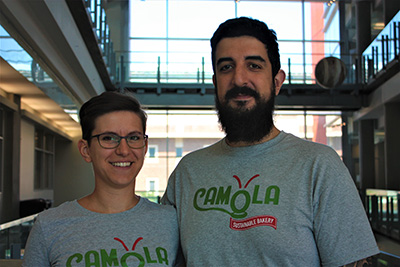
Silvia Ronzani and Claudio La Rocca co-own Camola Sustainable Bakery, which produces baked goods sold at the UAlberta Farmers Market that contain flour made from ground-up crickets,
Would you eat crickets? Willingly? Regularly?
Two young scientists with graduate educations from the Faculty of Agricultural, Life and Environmental Sciences are betting you will-if not this week, then soon after your first opportunity.
Silvia Ronzani and Claudio La Rocca are co-owners of Camola Sustainable Bakery, a new business that produces numerous tasty treats-including granola bars, cakes, sourdough breads, pizzas and "bugscotti"-all of which are prepared by including some flour made from ground-up crickets.
"(The amount) is less than the regular flour but way more than a spice," says Ronzani, the partner who develops the recipes. While the exact proportion of cricket flour is their trade secret, it's definitely enough for consumers to derive the many benefits of eating bugs, says La Rocca.
"Insects are almost pure protein-crickets specifically are 67 per cent," he says. "There's almost no fat, little water, little carbs. They are very rich in micronutrients-so iron, calcium, potassium-and high in vitamin B12. A tablespoon of cricket flour gives you 100 per cent of your B12 for the day."
Additionally, he says, they require far fewer resources to farm than traditional sources of protein. "One kilogram of cricket flour requires a little less than four litres of water. One kilogram of beef, depending on the farming system, is estimated to take 22 to 44 litres of water."
Both La Rocca and Ronzani are insect scholars-each are authors of separate master's theses about the relationship carabid beetles have to the environment. La Rocca earned his graduate degree from the Department of Renewable Resources in 2016 and Ronzani will soon do so from the same department. However, La Rocca learned about edible insects through extracurricular research, which he started after a classmate invited them to eat home-roasted crickets, three years ago.
That information, plus skills learned at UAlberta's business incubator eHub, helps them convince reluctant potential customers to taste a cricket-flour product.
At the places they sell-since September it has been the university's Farmers Market on Thursdays and the French Quarter Market on Sundays-there is always a jar of the flour for the curious to sniff. After people realize there's nothing offensive about the smell, they are offered a free sample and discover that when paired with sweet ingredients, cricket flour promotes a chocolaty, nutty flavour; in salty items the flavour exuded is earthier, more like mushrooms, says La Rocca.
Next, the duo answers all the usual questions and shares edible-insect factoids. For instance: Camola buys its flour from producers in Ontario, who grow the crickets for approximately six weeks, then freeze, roast and grind them. Also, two billion citizens of the world (in Southeast Asia, South America, Africa and part of Oceania) include insects in their regular diet. North Americans and Europeans, meanwhile, have been unknowingly eating insect parts for centuries, says La Rocca.
Natural red food colouring (also known as carmine Red, Natural Red 4 or E120) is derived from ground cochineal bugs that are scraped from cacti leaves, he says. The ingredient in jelly beans that makes them shiny? It's shellac, a resin secreted by the female lac bug from India and Thailand.
"Even without those two specific ingredients, USDA regulations and probably the CFIA's, too (Canadian Food Inspection Agency), say that food is allowed a specific amount of insect parts," says La Rocca. "For each of us, that's about two pounds per year. With everything that comes from a field, it's impossible for it not to have insects."
Some people purchase a Camola treat right away, but more often they think about it and return a week or two later, won over by the strength of several compelling ideas, says La Rocca.
"It's a culinary adventure. You are trying new tastes, it's good for the environment and it's also good for your health."
The couple hopes it will be good for their future, too. They plan to sell online and at more farmers markets in 2018, then expand production in a commercial kitchen and attract investors.
"In a way, we are still working in our field," says La Rocca. "We are working on environmental problems and in entomology."